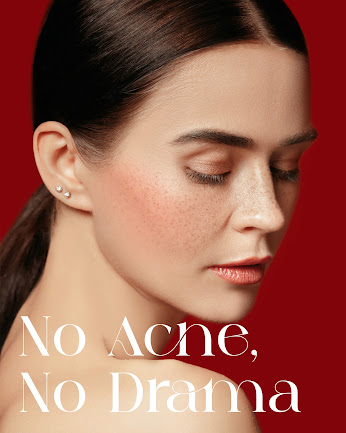When Your Skin is Both Oily and Dehydrated: What’s Going On & How to Heal It
What’s the Difference: Oil vs Water in Skin
-
Sebum (oil): Produced by oil glands (sebaceous glands). Offers some protection, keeps skin from being too dry, gives a sheen.
-
Water content (hydration): Comes from internal moisture (drinking water, diet) + water held in skin cells. Helps skin stay plump, smooth, flexible.
When your skin is oily but dehydrated, it's producing plenty of surface oil, but the inner layers are lacking water. This causes tension, tightness, flaking sometimes even breakouts alongside shine and greasy feeling.
Signs You Might Have Oily + Dehydrated Skin
Look out for:
-
Your T-zone (forehead, nose, chin) is shiny or greasy, especially a few hours after cleansing.
-
Cheeks, jawline, or under-eyes feel tight, rough, or flaky, especially after washing.
-
Skin feels uncomfortable after cleansing, even though you see oil.
-
Your pores look large or more visible.
-
Skincare products sting or burn sometimes barrier is compromised.
-
Makeup doesn’t sit well; it looks patchy in dry areas but slides off in oily zones.
Why This Happens — Common Triggers
Several internal and external factors can pull your skin into this unbalanced state:
External Triggers
-
Harsh cleansers that remove too much oil and strip natural moisture.
-
Over-exfoliation, whether mechanical (scrubs) or chemical (strong acids) can damage the skin barrier.
-
Weather/environment, like extreme heat, cold, dry air, wind, air conditioning all draw water out.
-
Using alcohol-heavy toners or astringents, thinking they’ll solve oil issues they often worsen dehydration.
Internal Contributors
-
Not drinking enough water, or hydration depends solely on skincare.
-
Poor diet: low in water-rich foods (fruits, vegetables), essential fats, antioxidants.
-
Hormonal fluctuations (puberty, menstrual cycle, stress) increasing oil output and affecting barrier health.
-
Stress, poor sleep both can impair skin regeneration and barrier repair.
A Skincare Routine That Restores Balance
Here’s how to rebuild moisture without making oil issues worse:
| Step | What To Do |
|---|---|
| Cleansing | Use a gentle, non-stripping cleanser (gel or low-foam). Limit cleansing to twice a day. Avoid sulphates or harsh surfactants. |
| Hydrating Toner / Mist | After cleansing, use a water-based toner or mist with humectants (glycerin, aloe, hyaluronic acid) to reintroduce water. |
| Targeted Serums | Lightweight serums with ingredients like hyaluronic acid, panthenol, niacinamide. Niacinamide is especially good: helps with oil regulation and strengthens the barrier. |
| Moisturiser | Use oil-free or gel-cream moisturisers. Include barrier-repair ingredients (ceramides, essential fatty acids). Apply while skin is a little damp to lock in moisture. |
| Sun Protection | Broad-spectrum SPF every morning. UV rays damage the barrier, increasing water loss and triggering more oil production. |
| Exfoliation | Be gentle and sparing. Use mild chemical exfoliants (like low-concentration AHA or BHA) once or twice weekly avoid physical scrubs. |
| Barrier Repair | Include ingredients like ceramides, cholesterol, fatty acids to rebuild the lipid barrier. That keeps moisture in and external irritants / oil-triggering factors out. |
Lifestyle & Diet Tweaks That Help
-
Drink enough water aim for at least 1.5-2L per day (adjust based on climate, activity).
-
Eat more moisture-rich foods: watermelon, cucumber, citrus, soups; plus healthy fats like avocado, nuts, seeds, fish.
-
Avoid excessive caffeine and alcohol (they can dehydrate).
-
Humidify your environment if it’s dry (air con, heaters, dry seasons).
-
Sleep well and manage stress skin regeneration happens during sleep, and stress hormones can imbalance oil and moisture dynamics.
Things You Shouldn’t Do
-
Don’t skip moisturiser it seems counterintuitive but skipping it makes dehydration worse, which in turn may ramp up oil.
-
Don’t use harsh astringents or over-strip with strong acids every day.
-
Avoid heavy occlusives (thick oils, petroleum) that can clog pores, unless they are non-comedogenic and you patch test.
-
Don’t forget SPF sun damage accelerates moisture loss.
When to See a Dermatologist
If you’ve been consistent with a gentle, balanced routine for 4-6 weeks and still:
-
see worsening signs (inflammation, acne, peeling, persistent tightness), or
-
suspect an underlying skin condition (eczema, rosacea, fungal acne), or
-
find you need stronger, prescription-level care (for example, for barrier repair, anti-inflammatory agents),
then consulting a dermatologist is the right move. They can help diagnose, possibly prescribe barrier repair creams or gentle retinoids, or recommend professional treatments.
Summary: Bringing Your Skin Back to Equilibrium
Oily + dehydrated skin is frustrating, but it’s fixable. The key is to replenish water deep in the skin, protect and rebuild the barrier, without using aggressive oil-stripping or clogging products. With the right routine, patience, and lifestyle adjustments, you can shift toward skin that’s balanced, comfortable, hydrated but not overly shiny.
FOR MORE INFORMATION VISIT
Reveal Radiance: Why Cathy Doll Whitamin C Peeling Gel Is a Must-Have in Your Skincare Routine
Do Face Serums Really Shrink Pores? Here’s the Truth You Need to Know!
Cathy Doll Helps You Reveal Spotless, Clear Skin
How Moisturizers Play a Vital Role in Fading Hyperpigmentation?
Summer Skincare Secrets: Stay Fresh, Hydrated & Glowing
From Morning Fresh to Evening Glow: The Dewy Skin Blueprint
How to Fade Dark Spots Naturally with a Gentle Skincare Routine
Sleeping Masks vs. Night Moisturizers: Which One Is Right for Your Skin?
Glow Without the Grease: How Vitamin C Transforms Oily Skin?




Comments
Post a Comment